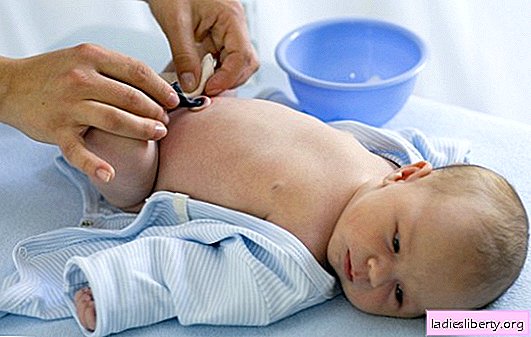
The first month of a newborn’s life is a time of increased attention to the slightest changes in the condition of the child, because it is at this age that significant and important changes in the body occur.
It is necessary to monitor the state of the navel in the newborn, because the umbilical wound heals within 2 to 3 weeks, and the baby and mother are discharged from the hospital on the 5th day. Often, healing processes occur slowly, the navel in a newborn is bleeding, suppuration occurs in the umbilical ring. This happens in every tenth newborn and can lead to serious complications.
When navel bleeding is dangerous
In the place where the umbilical cord falls off, a wound is formed. For some time this place is bleeding. In the future, the formation of crusts. After their removal, the place of the dropped umbilical cord remains bleeding again within a week. If everything ends within the specified time, this is a normal physiological phenomenon.
The following hazardous cases require attention:
• bleeding of the navel lasts more than 10 days from the date of birth;
• if bleeding continues even after treatment of the wound;
• with the development of granulation of the wound in the navel.
Navel in a newborn is bleeding - reasons
It is always necessary to know the cause of bleeding in order to know how to act. To the fact that the navel is bleeding in a newborn, it leads:
• error when removing the umbilical cord residue - incorrect trimming;
• a thick umbilical cord, leaving a wide wound after healing, which will heal for a long time;
• improper care for a bleeding navel;
• the use of aggressive care products, after processing with which the navel does not have time to heal;
• low blood coagulability;
• increased fragility of blood vessels;
• early laying of the newborn on the stomach;
• lack of immunity.
In cases where the umbilicus is bleeding in the newborn and the timing of bleeding has dragged on, you need to contact a pediatrician. It must be remembered that the problem with excessive navel bleeding will not be resolved on its own, but may be exacerbated by complications.
A belly button in a newborn is bleeding - care rules
Some rules for caring for a bleeding wound in the navel area, which must be followed to reduce healing time and avoid complications:
• it is necessary to treat the wound no more than 1 time per day so that the wound has time to epithelize;
• the procedure is best done after bathing, when the crusts are softened and easily removed;
• do not use aggressive agents to treat wounds;
• it is advisable to use chlorophyllipt so that the wound does not disguise itself, as after the treatment with "green stuff", but is visible - this makes it possible to detect any irregularities in time;
• you can’t stick the wound with adhesive tape to avoid trauma and prolong the healing time - in the absence of air, ideal conditions are created for the development of infection;
• use only boiled water for bathing the child;
• make sure that the wound is not injured by clothing or a diaper;
• for the same purpose, do not spread the newborn on the stomach and avoid situations when the child strains the abdominal muscles (strong straining, screaming, prolonged crying);
• exclude clothes from synthetic fabrics that create a greenhouse effect and prevent skin from “breathing”;
• clothing made from natural fabrics, on the contrary, does not inhibit the healing process due to air ventilation;
• for the same purpose, more often ventilate the nursery to prevent diaper rash and harden the child.
Technique for processing the navel of a newborn
Directly processing the umbilical wound consists of the following steps:
1. Disinfection of the wound with hydrogen peroxide: drop hydrogen peroxide onto the wound from a pipette. The crusts will soak in a few minutes and become soft.
2. Gentle removal with a cotton swab of soft crusts. Do not use force or peel dry crusts so as not to cause bleeding.
3. Blot the wound with a sterile cloth to make it completely dry.
4. Lubricate the entire umbilical ring with an antiseptic (1% chlorophyllipt or calendula tincture), trying not to touch healthy skin. It is not recommended to use “greenback” or potassium permanganate solution: they mask the wound with their saturated color, because of which you can skip redness, swelling, suppuration. Chlorophyllipt - an alcohol tincture of eucalyptus - is safe for use in a newborn, non-aggressive for the skin of an infant, copes well with staphylococcus, being a good antimicrobial and anti-inflammatory agent. The tincture of calendula has a similar effect.
5. It is not recommended to use more than two antiseptics.
Alternative navel treatment
It is believed that alcohol, hydrogen peroxide, a strong solution of manganese are too aggressive and interfere with wound healing. It is believed that if you keep the wound dry and clean, its epithelization will occur in 7 days.
According to new recommendations, the so-called “dry” method of conducting a bleeding navel is based on the fact that the mummification (drying) of the stump occurs naturally, spontaneously, in fresh air, without dressings and antiseptic treatment. It is important that there is free air access (ventilation, tucking of the diaper so that it does not cover the navel, free swaddling) and the navel is kept clean (if dirty, wipe it with a clean gauze swab dipped in boiled water and dried).
General hygiene rules for processing
Until the complete healing of the navel, the general hygiene rules must be carefully observed:
- Thoroughly wash and disinfect hands before treating a wound.
- Repeatedly changing the undershirt and sliders during the day, even if they are dry.
- Mandatory ironing of all children's clothing.
- Exclude touching the navel with a diaper belt. There are special models with a cutout in the center. You can make such a cutout for the navel in a regular diaper.
Navel in a newborn is bleeding - complications after infection
If all the processing rules are followed, but there are discharge with an unpleasant odor, redness or swelling, you must consult a doctor to avoid further complications.
If nevertheless appeared:
• hyperemia;
• swelling and soreness when touching the stomach;
• bleeding and discharge of pus from the umbilical fossa;
• increase in temperature above 38 C, which means infection occurred - developed omphalitis, or a weeping navel. Most often, omphalitis develops in children whose parents prefer a "dry" navel treatment.
Omphalitis is a bacterial infection of the skin and subcutaneous tissue at the site of the umbilical wound. If the process affects the vessels of the navel, we are talking about another pathology - arteritis.
The main causative agents of these complications are staphylococcus and Escherichia coli, which penetrate the unhealed umbilical wound.
Omphalitis and arteritis are the result of insufficient care for the newborn.
There are three forms of omphalitis:
• simple;
• phlegmonous;
• necrotic.
They differ in the course, severity of the condition and the timing of treatment.
Navel in a newborn is bleeding - when should I see a doctor
At the first sign of infection, you should immediately consult a pediatrician.
Further treatment occurs only under the supervision of a physician. Antibiotics, antiseptics, antibacterial ointments are used, in severe cases, treatment occurs in a hospital.
It is impossible to use antibiotics and potent ointments (antibacterial or hormonal) on their own in connection with many side effects that develop when the dosage is wrong.
You should also consult a doctor in the following cases:
• non-healing navel within 3 weeks;
• inefficiency of treatment with hydrogen peroxide: bleeding continues;
• the navel is bloody and protrudes strongly - it can be an umbilical hernia.
Navel in a newborn is bleeding - prevention
An important aspect in the timely healing of navel hemorrhage is measures that contribute to the rapid cessation of bleeding and the prevention of complications:
• careful care for the umbilical wound, as mentioned above;
• if there are no indications for antiseptic treatment, use the “dry” method of caring for the umbilical cord residue;
• increase the protective forces of the child's body;
• strict provision of all possible types of care for the newborn at home (bathing, washing, clean clothes, frequent airing and taking air baths, changing diapers, sliders, navel skin control);
• adults wearing clothes made from natural fabrics with the refusal of navel piercing, scarring, and tattooing to prevent injuries to the baby's belly button.
A major role is played by:
• breastfeeding immediately after birth;
• constant joint stay of the newborn with the mother from the first minutes;
• contact with the skin of the mother as soon as possible after birth to populate the navel and skin of the baby with the microflora of the mother.
With the appearance of hemorrhage of the navel in a newborn, one cannot expect that everything will go away on its own. You need to immediately consult a pediatrician and clearly perform all appointments in order to avoid complications.
Attention to the condition of the child, proper care and timely treatment will help to maintain health and do without unpleasant consequences.











